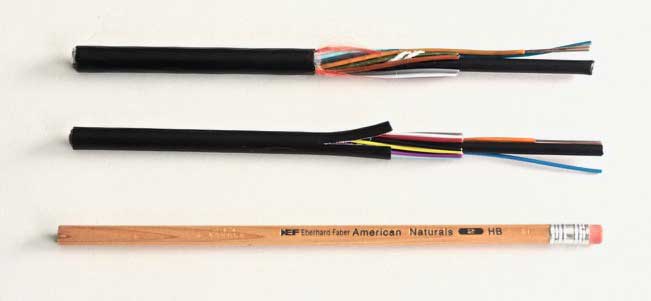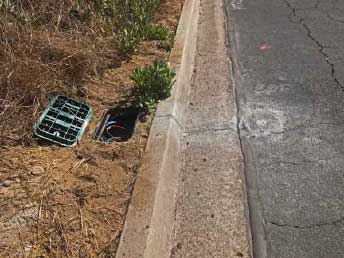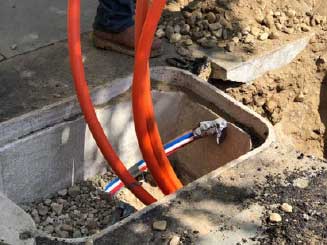

| Fiber
Optic Microcables
Microcable is a term applied to a new class of cables that are very high density cables with greatly reduced the cable diameter. Two fiber developments make a microcable feasible. Bend insensitive fiber allows fibers to be packed into cables with much higher density since the fibers are not as sensitive to the stress caused by the crowded fibers. In addition, the bend insensitive fibers can be coated with smaller diameter primary buffer coatings, 200 microns or less compared to 250 microns for conventional fibers, allowing more fibers to be packed into a smaller space.  Corning microcables - 288 fiber (top) and 144 fiber (middle) compared to a pencil The
differences between conventional and micro cables are
substantial. A 144 fiber loose tube cable is typically
15-16mm diameter while a comparable micro cable is only
about 8 mm diameter - half the size and about one-third
the weight. The smaller size allows for much larger fiber
counts, up to 6912 fibers in some high
fiber count designs, Microcables generally have a
large stiff strength member in the center to allow
installation by blowing the cable into microducts.
Microducts
come in a variety of sizes and shapes, including versios
not show her that are flat, say 6 microdcuts in a row,
intended for installation in very narrow grooves cut in
microtrenching. Multiple tubes are often installed to
allow for future network expansion by simpler installation
of future cables without any construction, reducing costs
and disruption in the area of construction..  Corning Microcables in microducts compared to a normal cable in duct (R) Microcables are available for both premises and outside plant installations. Their small size allows a different installation technique where the cable is "blown" into micro ducts, plastic tubes much smaller than conventional fiber innerducts or conduits. The cable is not really blown into the duct but floated on air to reduce friction then pushed into the duct.  Blowing cable Careful design, construction and installation can make microcables almost invisible, as in this installation along the seam between a curb and the roadway paving.  Microducts can also be installed by directional boring, often along with conventional ducts, as shown here. There is a bundle of 6 microducts installed along with 3 conventional 1.25 inch fiber ducts.  After installation, microcables can be prepared and spliced using conventional techniques. Return to the FOA Guide Table of Contents. |
|
|
|
|